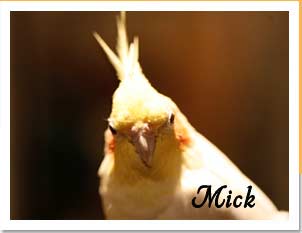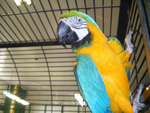Teflon and Birds: What You Need to Know
by John Graziano

Almost all avian caregivers have heard the horror stories about birds exposed to Teflon fumes. While most of us are aware of the dangers of Teflon cookware, it's often unclear which products contain Teflon and what uses are considered "safe". While it's almost impossible to eliminate all Teflon from our homes, a bit of knowledge and research can help avoid some of the most dangerous products.
What is Teflon?
Teflon is DuPont's brand name for a chemical called polytetrafluoroethylene, abbreviated as PTFE. PTFE is chemically inert, an excellent insulator, and is one of the slipperiest solids known to science. Since Teflon's invention in 1938, it has been used in a huge number of applications, from nuclear power to spacecraft to the roof of the Humphrey Metrodome in Minneapolis. It is also present in many products that we use on a daily basis.

PTFE cookware is sold under many brand names besides Teflon. These include T-Fal, Silverstone, Flura, Excalibur, Supra, Xylon, Greblon, Resistal, Duracote, Autograph and Scanpan. But PTFE use is not restricted to the kitchen. It is also present in water- and stain-resistant fabrics, space heaters and heating pads, and even easy-glide dental floss. And while many companies label their products as containing PTFE, they often go to great lengths to make the labels difficult to find, or to distract consumers with claims of "green" manufacturing.
Dangers of PTFE
While there are many environmental and workplace risks associated with the manufacture of PTFE, the most common danger is exposure to fluorocarbon gasses given off when PTFE is heated. This reaction, known as "pyrolysis", gives off toxic and carcinogenic compounds, most of which are odorless and colorless. Chief among these gasses is tetrafluoroethylene, a known carcinogen, and carbonyl fluoride, a gas similar to the chemical weapon phosgene.
It is carbonyl fluoride which causes the most deadly effects in birds. It disrupts the absorption of oxygen in the lungs, leading to hemorrhaging and suffocation. Humans are also susceptible to carbonyl fluoride, but the worst effects we'll likely suffer are flu-like symptoms. Birds, with their highly-efficient and sensitive respiratory systems, are at risk of death with even brief exposure.
PTFE begins pyrolysis at around 392° Fahrenheit, a temperature easily reached during normal use of nonstick cookware. When heated to 500°, PTFE begins to break down, giving off much higher concentrations of fluorocarbons. Also, scratched or damaged coatings can give off carbonyl fluoride under even mild heating.
PTFE in the home
The most common household use for PTFE is nonstick cookware, but it's used in many products where low-friction, waterproofing or electrical insulation is important. Clothes irons use it to provide smooth, snag-free ironing. Self-cleaning ovens are often coated with PTFE to allow food ash to slough off during cleaning. And almost all heating pads and electric blankets contain wires coated in PTFE.
In addition, many fabrics use PTFE for water or stain resistance. Brand-name products like Gore-tex, and fabric treatments like Scotchguard and Stainmaster, all use PTFE as their principle ingredient. CoolMax fitness clothing (also produced by DuPont) is starting to add Teflon to aid in moisture evaporation. In these cases, the PTFE is applied in microscopic granules, giving it a much higher surface-area for potential outgassing. Even the relatively low heat of a dryer or clothes iron may result in the production of some carbonyl fluoride.
Many appliances that use heated air contain PTFE to keep dust from collecting on the fan blades and causing a fire hazard. Unfortunately, these appliances pose another hazard when used near birds. Many people have reported deadly results when space heaters or hair dryers were used near birds.
Mechanical lubricants, especially those targeted at high-temperature applications, often include PTFE as a major ingredient. Avoid lubricants that contain Krytox, another form of PTFE marketed by DuPont. While we should always avoid having a bird around any running machinery, there's no need to add to the risk with toxic fumes from PTFE. Also, you should never use any spray lubricant around your birds, regardless of the ingredients.
PTFE replacements
Cookware: Unless explicitly told otherwise, you should always assume that a non-stick pan contains PTFE. Other cookware such as baking sheets, drip pans and even "quick-release" aluminum foil contain PTFE to aid in cleanup.

Recently, a few PTFE-free nonstick coatings have appeared on the market. The most popular brand is known as Thermolon, a ceramic mineral coating similar to the powder-coating on bird cages. The first cookware to use Thermolon was GreenPan, which has a full line of PTFE-free pans and baking dishes.
Beware, though, of pans that advertise themselves as "Green" without specifically stating that they are PTFE-free. These pans may use a more environmentally-friendly manufacturing process, but they still contain as much PTFE as your old Teflon pans.
Of course, the safest choice is simply to avoid nonstick pans completely. There is little need for nonstick cookware in the kitchen, especially when a decently-seasoned cast iron pan will perform just as well. (See "how to season a cast-iron pan" at the end of this article.) Stainless steel or enameled cookware can also stand in for PTFE pans, although more oil may be required to completely prevent delicate food from sticking.
Heating pads: It is almost impossible to find a heating pad or electric blanket that does not use PTFE-coated wires in its construction. Since these wires are specifically meant to be heated, they are in danger of outgassing -- especially if the wires are old or cracked. If you need to provide heat for your bird, use a ceramic bulb or other infrared source that does not rely on heated wires.
Space Heaters: Many space heaters have PTFE-coated elements, and the labeling is not always helpful. The best solution is to avoid hot-air heaters altogether and instead opt for an oil-filled heater. These heaters have no exposed elements, so there is no need for them to use PTFE in their construction.
Fabrics: Any fabrics that advertise water or stain resistance likely contain PTFE, as do many CoolMax fitness products. If you need to use these materials, make sure that you do not dry them or iron them on high heat. If you don't absolutely need the PTFE-provided qualities of these materials, consider using safer fabrics.
Lubricants: Many graphite-based lubricants can substitute for Krytox, although some manufacturers have started using both graphite and PTFE in their products. Consult with the manufacturer before using any high-heat lubricant around your bird.
PTFE in the future
PTFE is used in so many products that it's unlikely to be phased out in the near future. In order to keep our birds safe, we not only need to know which current products contain it, we need to understand the ways in which PTFE is used so that we can identify any new products as possibly containing PTFE.
Any cooking product advertised as nonstick, quick-release, or easy cleanup, should be considered guilty until proven innocent with regards to PTFE. If a manufacturer has gone to the trouble and expense of using a PTFE-free coating, they will tell you about it in BIG LETTERS. If you don't see a clear label stating that a nonstick product is PTFE-free, it is likely to contain at least some PTFE in the coating.
Fabrics promoted as stain or water resistant almost certainly contain PTFE. You should expect that any new stain or water-resistant material contains PTFE unless it says otherwise.
Finally, be wary of products from large PTFE manufacturers like DuPont or 3M. PTFE is a valuable commodity and manufacturers are always looking for new ways to exploit it. When you see a product advertised as easy-to-clean, resistant to stains or water, or useful as a lubricant, expect that it contains some form of PTFE. Any time you are using -- and especially heating -- a product that is new to the market, make sure you do it well away from your birds and with good ventilation. And don't be shy about calling the manufacturers directly. They will tell you if a product contains PTFE, even if they won't say so on the packaging.
Removing or reducing the amount of PTFE in your household is not always an easy task. New products come on the market every day, and manufacturers are not exactly eager to call attention to their use of PTFE. But with our birds depending on us for their safety, it's worth a little extra time (and expense) to make sure they live long and healthy lives.
----------------
How to season a cast-iron pan

Note: Any fat that is solid at room temperature (Crisco, palm oil, bacon grease) will work for seasoning, though saturated animal fats seem to work the best (sorry, vegans). Liquid oils will also work, but the seasoning may not be heavy enough to last. Also, do not use butter unless it's been very carefully clarified (e.g. Indian Ghee). Whole butter will simply smoke up your kitchen and do nothing for your pan.
1. Scour a cast iron pan to remove any rust or factory-applied sealants. Dry the pan completely.
2. Heat the pan until it is barely warm enough to melt fat, but still cool enough to handle.
3. Coat every part of the pan -- top, bottom, handle -- with fat, spread on with a paper towel.
4. Place the greased pan upside-down on a wire rack in a cold oven. Try to keep as little contact as possible between the pan and the rack.
5. Set the oven to 375° F and bake for 2 hours
6. Turn off the oven, leave the pan in the oven until completely cooled. At this point the coating on the pan should feel pretty gummy in spots.
7. Place the pan back in the oven and turn the heat to 525° F.
8. Bake for 1 hour, then cool in the oven as before.
When finished, the pan will have an enamel-like coating of hard seasoning on every surface. Once your pan is seasoned, never wash it with soap. If you need to scrub out your seasoned pan, use a little coarse salt and a dry cloth or paper towel.

